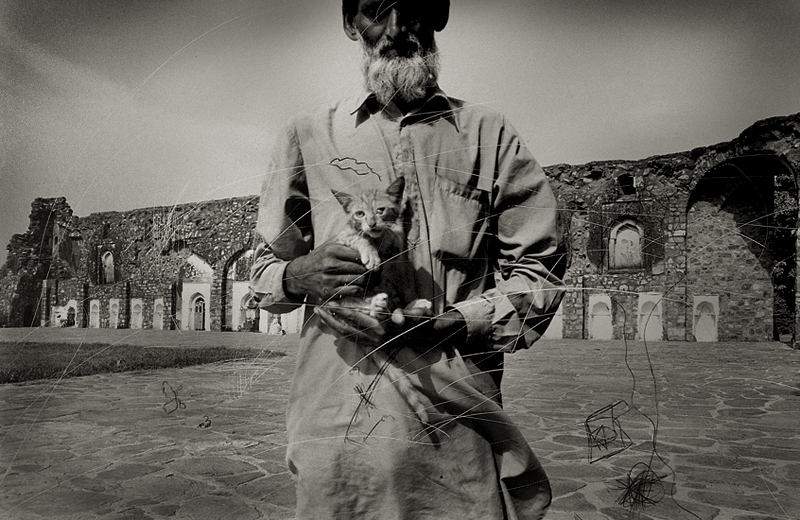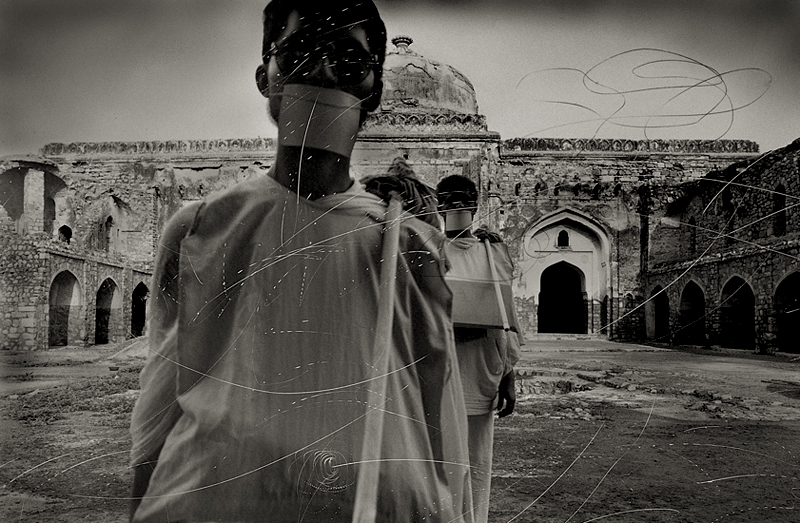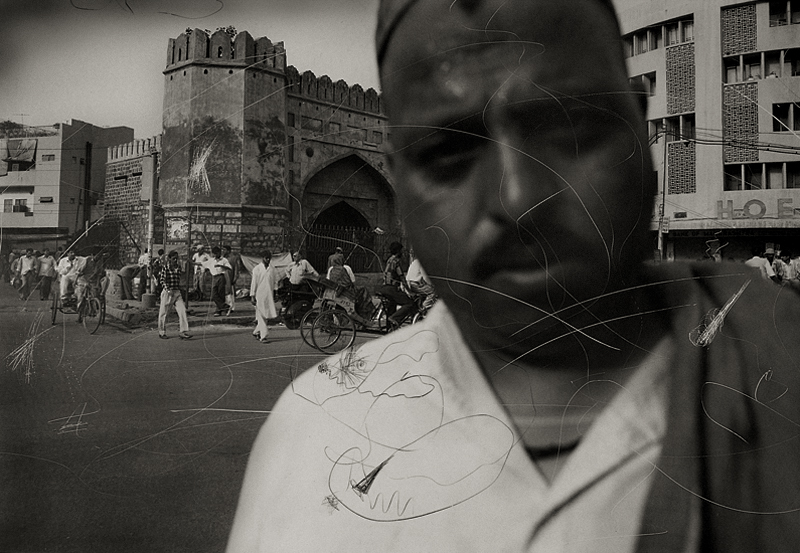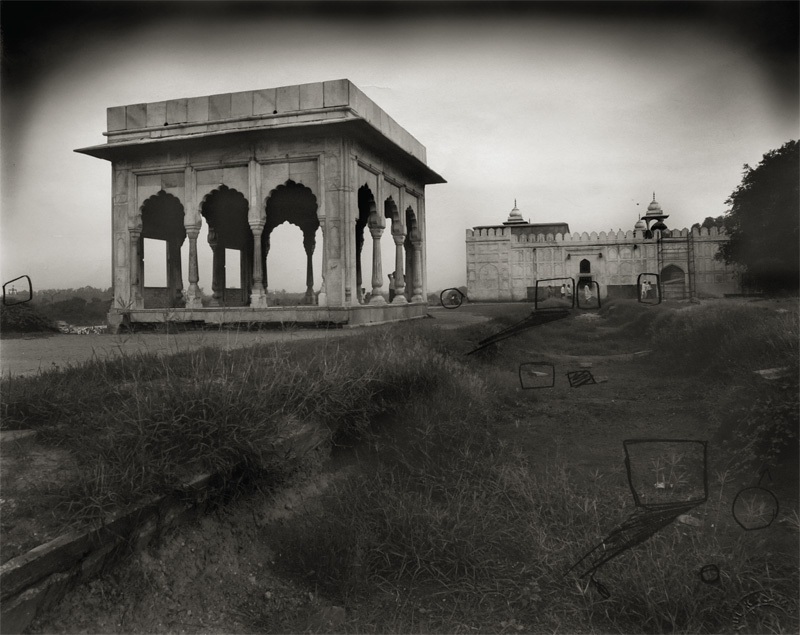This interview of Project 365 Director Abul Kalam Azad was originally published in Malayalam language in Deshabhimani Weekly. Interviewed by PP Sha Nawas. Translated to English by Bipin Balachandran and published in Art and Deal magazine.
Abul Kalam Azad is one of the foremost exponents of art-photography in India. His grandfather and father were migrants from a weaver’s family of Tamil Nadu who settled down at Kochi, Kerala. Later, his father became a successful textile merchant in Kochi. Azad learned photography from London and worked in France and Germany. He was a photo-journalist with P.T.I for twelve years. His wide friends’ circle in India and abroad include artists and intellectuals such as O.V.Vijayan, Vivan Sundaram, Geeta Kapur, Suneet Chopra, M.K. Raina, M. A Baby, R. Nandakumar to name a few. He was living in Mattanchery, Kochi. At present, he lives in Tiruvannamalai, Tamil Nadu.

(Question) Shanavas: How did you get the name of Abul Kalam Azad
(Answer) Abul Kalam Azad: It was my father who named me after Moulana Abul Kalam Azad, who was a supporter of the struggle for independence and befriended the leaders of Islamic reformation movement in Kerala. For my father, Azad was a name bearing the memories of that time. My ancestors were weavers from Tamil Nadu and they settled down in Kochi. We speak Tamil at home. So I find myself to be a South Indian Dravidian. As weavers and textile merchants, my ancestors were experts in appraising the texture and quality of silk.
(Question) SN: What about the Islamic tradition of your background?
(Answer) AKA: Though we belong to the Tamil Islamic identity, my dad’s sisters never wore a burqa. Today, it is interesting to note that every Muslim woman wears a burqa. How does one choose a dress according to religious belief? In Malabar (northern part of Kerala) Muslim women used to wear “vellakkachi and jumper”. My aunts would wear good silk saris and they were well dressed. We cannot view the changes in our cultural life without some trepidation. In fact we have assimilated various cultural models. Ravi Varma had to travel all the way to Gujarat and Maharashtra for a model clad in Sari. Sari or salwar-kameez, all these dresses are from outside cultures.

(Question) SN: You are noted among the Indian art photographers and are acquainted with a national and international metropolitan life. You have also worked with artists and intellectuals in London and Delhi and never tried to uphold any religious identity. But still my questions aim at your Muslim identity. How do you look at this?
(Answer) AKA: I was not aware of or no one ever mentioned about such an identity when I left Kerala. I worked in different parts of India like Delhi, Punjab and U.P. It was on one of those days that Babri Masjid was demolished and the B.J.P. came into power. Then this ‘identity-consciousness’ was created in everyone. And the polarization of Hindu-Muslim came into effect. It was like the fear of someone who has been caught between two specters. Obviously identity became problematic then. To be known by some names, such as M.F.Hussain, could be troublesome, causing culture and vision to start journeying through religious paths. I am talking about both religious fundamentalisms… Artists cannot speak about the Quran or nationalism or Saraswathy or Parvathy or Siva.
The Muslims of Kerala know Ganapathy (Lord Ganesh) or Nataraja Guru. They are familiar with Christ, Buddha and Marx. We know what Buddha Purnima is. We celebrate a cultural life which is rooted in sectarianism. People are being killed everywhere in the name of nationality and ethnicity. It has been repeating throughout history: Karbala, Jordan, Syria, Palestine and Congo. The Israel border is paved with land-mines. What about the Golan Hills? It has been kept deliberately as a reason to fight for. Bait-ul-Muqqadas is a holy place for Jews, Christians and Muslims. Everyone can go there. But now, it is a war-field. War goes on, on one side and the other, people lead their ordinary life, but in an unceasing fear of war; perhaps by forgetting reality as something natural.

(Question) SN: I have seen a photograph by you titled “Defend Secularism”, done for the Sahmat campaign of Delhi – an image of a man without a head, holding a lotus in front and a knife in the back. In fact, the posture is a bit sarcastic. It is aiming at the socially circulated fear created by the violence and holocaust you have mentioned, and at the same time, conveys an expression which soothes the fear of violence.
(Answer) AKA: It’s about social fear. Take for instance, the Gujarat issue. It’s a result of a conspiracy and cannot be justified, whether it’s Hindu fascism or Islamic fascism. Every ideology has the element of fascism in it. We try to be international. The effort is to make Islam an international religion; same dress code, same food, same education, same gestures and so on. A totality of “everything has-been-said-in-Quran-or-Marxism”. This totalitarian perspective is a big shortcoming of modernity. The views on secularism possess the same totalitarian aspect. How is it possible to unify the lives of people that show differences in culture and concepts? I prefer Gandhi’s fellowship that tries to be with people rather than Nehru’s elite state secularism. But I don’t negate the concept of secularism insofar as how much it is inevitable to vote for. At the same time, I don’t believe that secular culture can remediate the problem.
(Question) SN: Many readings are possible on Marxism. But, ‘Das Kapital’ is also an account of the execution of capitalism through the displacement of indigenous people and farmers.
(Answer) AKA: Mohammed and Marx are similar in certain ways, the concept of prophecy. The earliest concept of collectiveness might be of Buddha. The concept of modernity, a pantheism which sees everything as united. This is same as Mohammed’s idea of “thouheed” – concepts such as mihraj, meditation, enlightenment, Jahiliyyah phase etc., Buraq, Kamadhenu, flying, elevation concept of collective consciousness, monotheism – all these are contexts of man’s efforts to acquire knowledge. But, looking back today, it should be analysed as to where it has led us to. I have never seen an image of Mao with a gun in his hand, but today every Maoist has a gun in his hand. In these days everyone feels a credibility gap. Nothing is there to hope for. No way to know the truth – an entrapped situation. In one of my series I have tried to express this situation by using a bullet collected from Kashmir, a mouse-trap and a knife. I am searching for the absence of violence. That is why I go for the images of Narayana Guru and Nataraja Guru. I have done an image of Rajan (victim of Indian Emergency in 1975). But it was not out of any sympathy for Naxalism. His face was haunting me, not as a hero but as an embodied plight of everyone. I have pictured the incident of political murder of labourers in front of Mattanchery court: a tableau with dresses soaked in blood. In this way, violence repeats in the temper of Keralites. There might be some tribal motives which control our minds behind the political murders of Kannur. Racism is high in the so called civilized West. An Islam name holder has to encounter a kind of suspicion in Britain or France. Even the one who does not care about such an identity has to undergo special security checking in airports only because of one’s name. I am put into a group of people with Islam names. Perhaps, we cannot expect this kind of experience happening in India or Israel. This is the status quo of our modernity and secularism. Note that it is the same London where Marx’s tomb is situated. At 86, M.F. Hussain is forced to live the life of an exile in the name of his sketches. No one is discussing about his contribution to this country.

(Question) SN: Are these problems of identity and ethnicity responses to an all-embracing economic order?
(Answer) AKA: It may be so. In some places in Europe water is costlier than coca-cola. Then people would be forced to buy coca-cola. But ethnicity and casteism are deeper realities than this. It is embarrassing to know that there is a wall to keep the Dalits away in Tamil Nadu. Instead of demolishing the wall without too much attention, it has been granted to become a media-celebration by the government and political parties. There was a period when I looked at the Quran as nonsensical. I had the attitude of dissident. But now I can’t do it; I look at the Quran or the Bible or the Vedas as human knowledge created by laborious efforts.
My attempt is to get involved regionally and, through it, find out my universality. I arrange the images from regional lives and let them find their own ways. I don’t want to create immortality. David was not made to be immortal. Creations with a life span of only a few years. I don’t want to make a marble-image forever. Art should be simple and transparent, not shabby or fuzzy. The texture should be precise and coherent. A pig or a bison on a large canvas; and they will face the viewers by themselves. Works of art can speak for themselves. The artists of ancient India did paintings and sculptures, but not for adorning it with their signature. The Buddhist sculptures in Ajanta and Ellora did not bear the names of the artists who created them. In the Pallava and Chla period, no artists or artisans signed on their creations. They practiced art not for immortality. The function of the hand… it was Marx who said human history started when man began to use their hands. Man began to drive cars, to shoot, to paint, to sculpt, to raise his fists in protest, to wash his bottom only after he could stand straight and move his hands freely. So, the meaning of art is to know how one can use his hands and for what.

(Question) SN: As in your series, ‘Man with tools’ wherein you have pictured Pulaya, Paraya (the Dalit castes) and new-Hindus, you are looking at the renaissance movement in Kerala from the perspective of the Sree Narayana tradition, but why not from the Bhakti movement, though the images of the Tamil Nhakti movement are there in some of your works?
(Answer) AKA: My series ‘Untouchables’ is an answer to this question. (a series of work done during 2000-2005 with found photographs from Abul’s family album)
(Question) SN: What are the personal references in your themes? For instance, what are the imperatives that led you to the series ‘Animal’ in which motifs of animals were used?
(Answer) AKA: It is quite natural to have personal prototypes for such creations. To have a truth and narrative, we need such untruths. Personal interests, freedom and tastes are inevitable, but the sum of which may not be necessarily a personal assessment. My style so far is to present the images in a hybrid manner; to mix-up images from different or even paradoxical realms. But in this process, I do not emphasize on any particular concept, ideology or theology, because we cannot whole heartedly believe in any of them these days. We have experimented it all. Malayalis know. Now we have to break the wall to move forward. What is the medium used? How it is made? Is it printed in silver bromide costing two and a half lakhs? These questions are not important in art practice. I am searching for and trying to express the purity and virtue behind all these. The search is for a democratic space for art where even a local flex printer can create art.
Even though people live in modernity and sophistication there are some undercoats in their psyche, like the existence of Sufism in the lives of people who are still religious. This undercoat is the decisive factor in my imageries. That is my referral point. My use of light also comes from the regional life. I know that the brightness of the evening light is the specialty of that place. The trends in art cannot change the fundamentals.
Photography is the stillness of one by thirty seconds. To copy the dead time… the moments of last forever… photography creates a colonial fear… to shoot… to kill… photography shares the same method of homicide taught by colonialism. That is why we become frozen with horror before a camera. This terror is my medium, and there are some truths inherent in the medium. We are searching for that.
(C) All rights reserved. All the text and images published in this blog is copyrighted property of contemporary Indian photographer Abul Kalam Azad. Reprinting / publishing rights reserved by the author and prior permission is required for reproduction / re-publishing, For more information call {0}4175 237405 / {0}94879 56405 or mail to ekalokam@gmail.com / FACEBOOK – Abul Kalam Azad